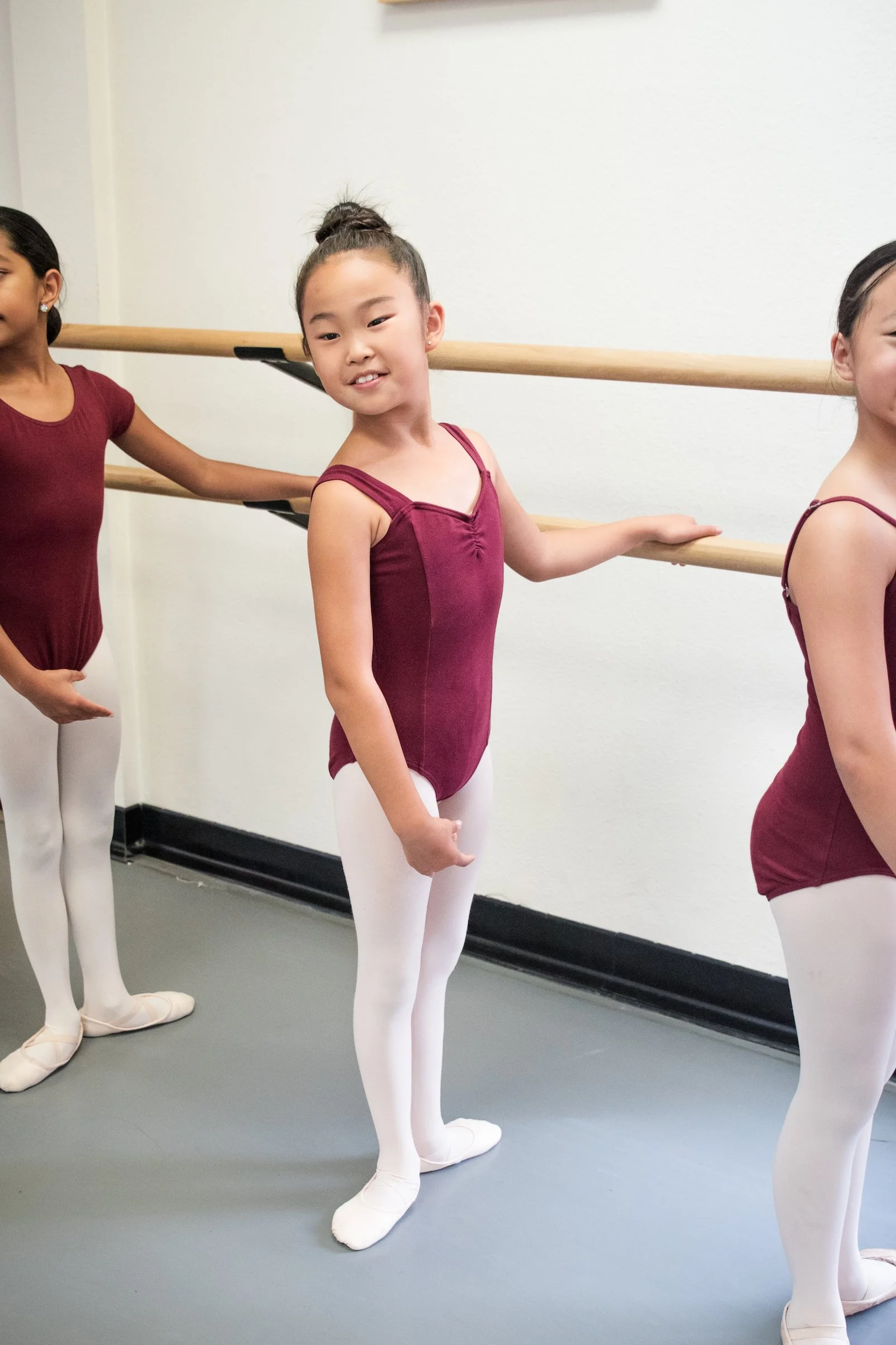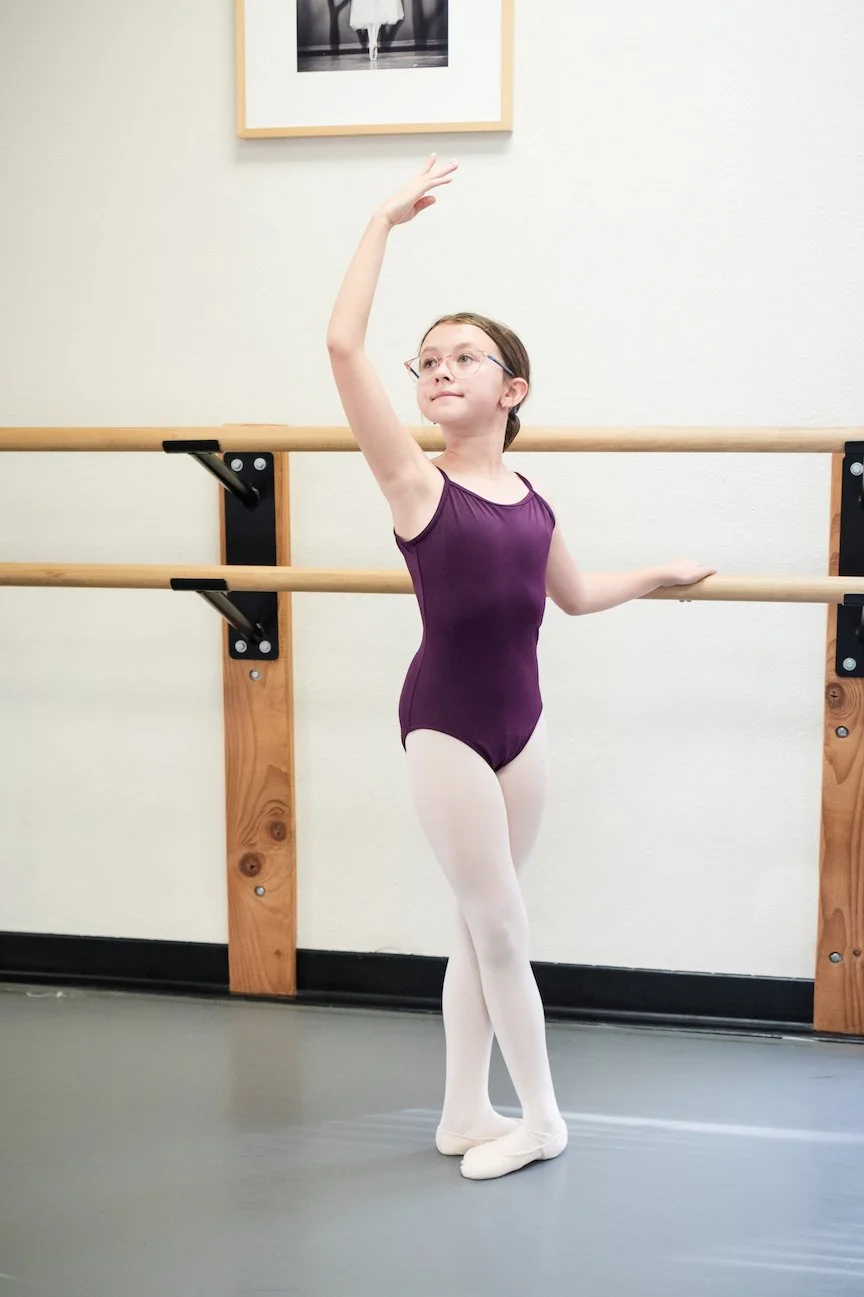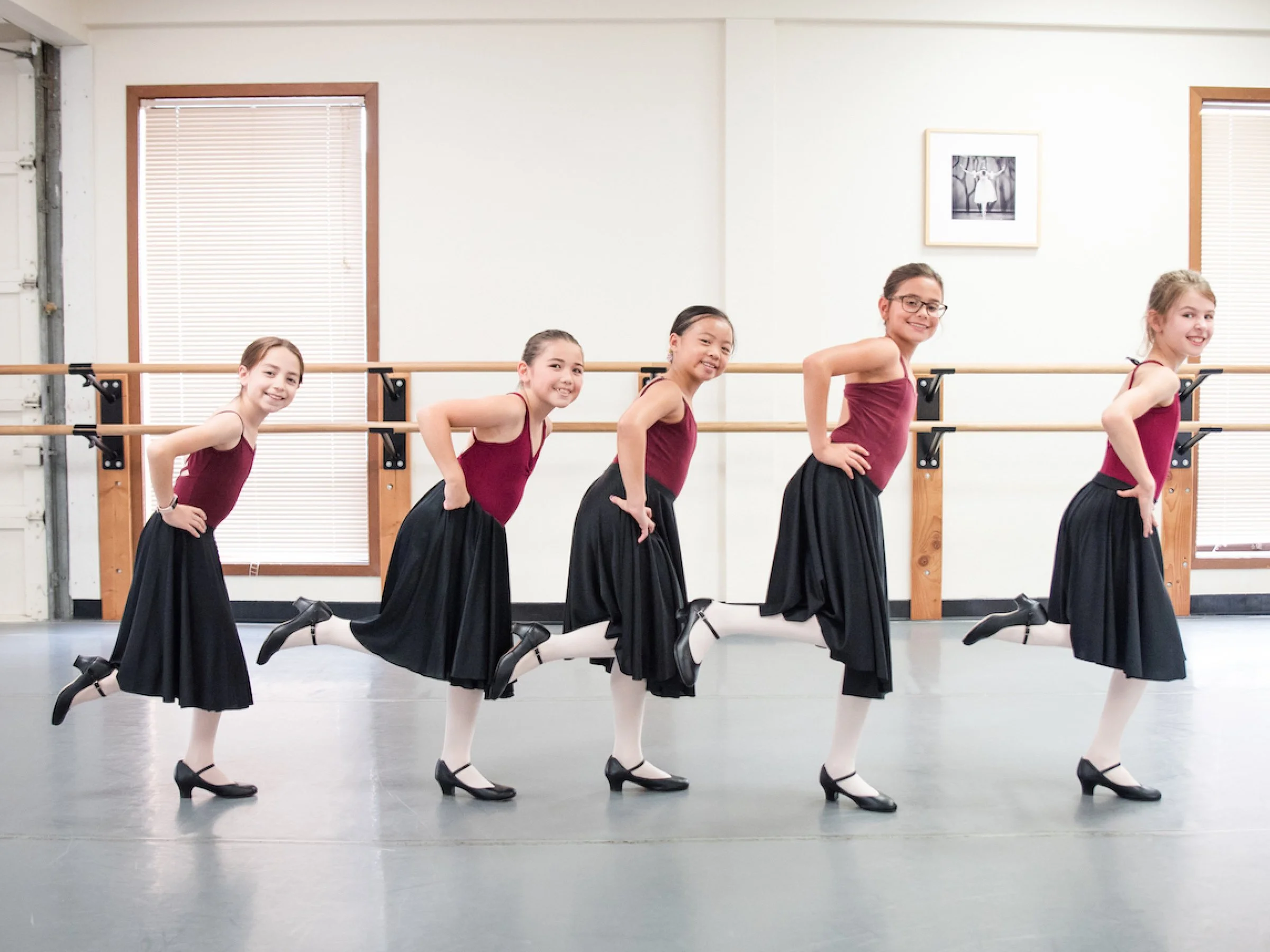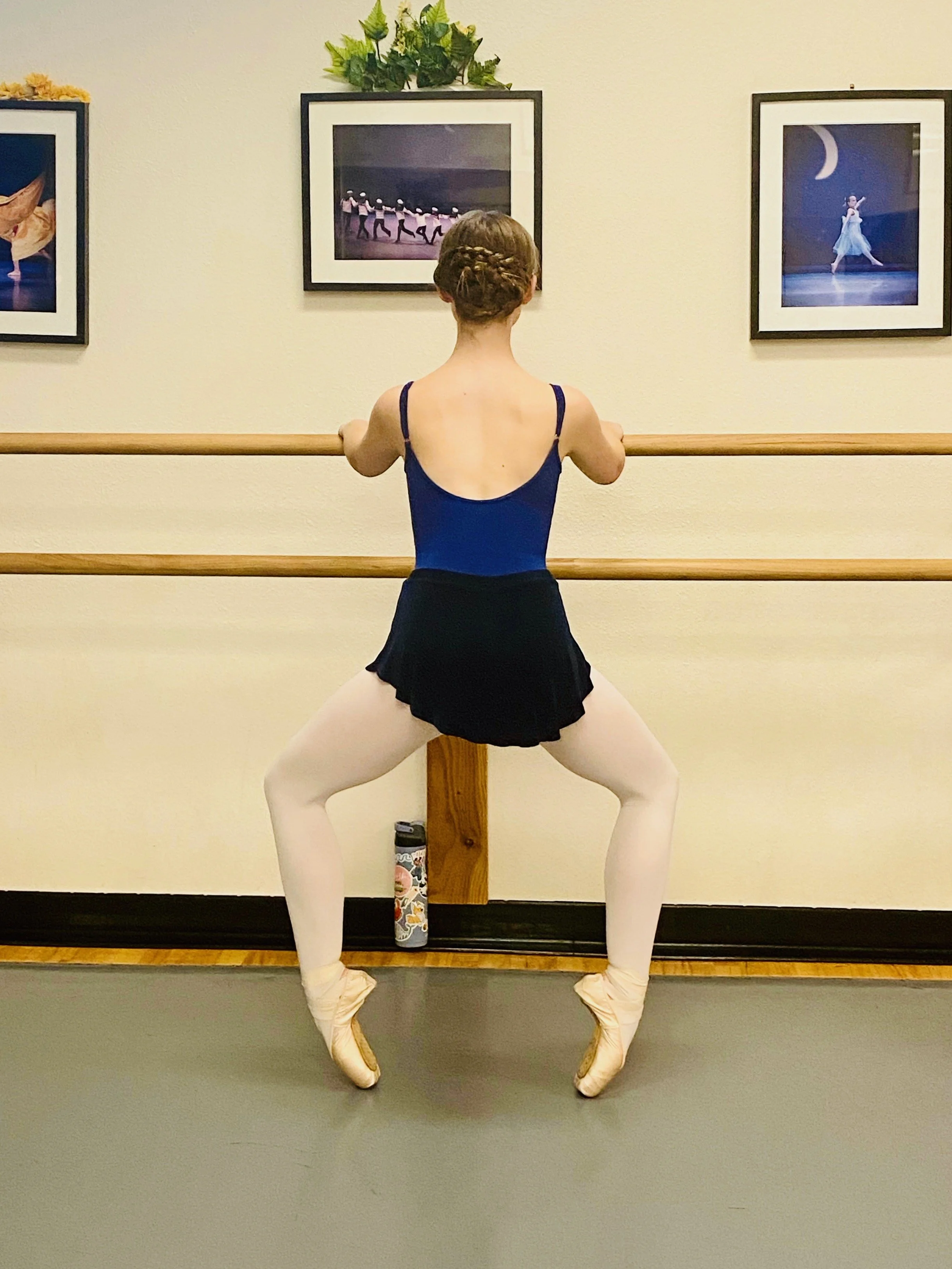We are proud to offer a free trial class for all levels of dancers
CURRICULUM
In addition to taking classes, Emerald Ballet Academy students have many performance opportunities throughout the year. Students who meet all requirements may also compete at Youth America Grand Prix (YAGP). View more information on our Boys’ and Young Men’s program here and PreBallet program here.
INTRODUCTION TO DANCE
A joyous introduction to music and movement. Boys ages 5-10 may enroll in Bounding Boys.
Little Movers (2.5-3.5 years old )
Emerald Ballet Academy’s Little Movers is designed to be engaging and enjoyable for toddlers and caregivers. Together, you’ll participate in simple ballet exercises, creative movement activities, and fun games that foster a love for dance and enhance physical development. The program is designed to help your child develop motor skills and coordination. In addition, our vision is to encourage your toddler’s creativity and love for music and movement.
PreBallet 1 (3.5-5 years old, Preschool)
A joyful introduction to movement and music. Children learn class etiquette, develop social skills, and have fun exploring creative movement. Basic dance technique is introduced and paired with beautiful music of all tempos. Famous stories of classical ballets are used to ignite imagination. Flexibility, coordination and strength develop with simple movements like skipping, galloping and leaping. A simple ballet barre making shapes (passé, arabesque, plié) is introduced. Creativity is encouraged through simple dance games.
PreBallet 2 (5-6 years old, Kindergarten)
A love of dance and movement is nurtured, and basic ballet technique continues to develop in an age-appropriate way. Basic technique is built at the barre adding in relevé, piqué and simple stretches. Chassé, skipping, bourrée, simple jumps and leaps are introduced. Flexibility, posture, coordination and strength increase. Simple dance games will still be used to help foster creativity and a love for dance. Children have fun, make new friends, and develop confidence.
Ballet Foundations
Stretching class is strongly encouraged at these levels. In order for dancers to establish clean technique and good habits, other genres of dance are not introduced.
PreBallet 3 (6-7 years old, 1st Grade)
Dancers begin to develop classical ballet lines and technique. A routine barre starts to develop with pliés, piqués, relevé, passé, arabesque, stretching and battements. A more structured center floor work routine is established to help prepare students for formal classical ballet training. Flexibility, coordination, strength and grace increase. Opportunities for performance are provided.
Ballet 1 (2nd grade)
Proper alignment, turnout, and flexibility are given special attention during this level in order to channel energy to artistry. A routine barre is established and dancers have a more structured center portion of ballet class. Dancers increase ballet vocabulary, grace, flexibility, musicality, and strength. Opportunities for performance are provided.
Beginning Classical Ballet
Stretching is strongly encouraged at these levels. Character class is recommended for B3+. Jazz is recommended for B4+. Note that A-levels are designed for middle and high school dancers newer to ballet, or those who want to dance only once or twice a week at Emerald Ballet Academy.
Ballet 2 (3rd grade)
Formal ballet training starts in this level. Barre work continues to emphasize correct placement, core strength, rotation, straight knees, and working through the feet. Dancers increase ballet vocabulary, grace, flexibility, musicality, and strength. Teachers will be more hands-on giving physical and verbal corrections as formal ballet training starts in this level. Opportunities for performance are provided.
Ballet 3 (4th grade)
Emerging dancers build on previous foundation skills. Barre work emphasizes strong backs, straight legs, footwork, and rotation. Dancers increase ballet vocabulary, grace, flexibility, musicality, and strength. Dancers also start to prepare for pointe in this level; ankle and leg strength are given a lot of attention. Barre and center work becomes more complicated and more attention is given to usage of head, arms and eyes to nurture a growing performer. Opportunities for performance are provided.
Ballet 4A (5th-6th grade)
For students newer to ballet, and not ready to have pointe shoes. Emphasis is on gaining a solid foundation in ballet, and enjoying dance. Opportunities for performance are provided. This level is also appropriate for those who want to dance only once or twice a week at Emerald Ballet Academy.
Ballet 5A (7th-8th grade)
For students newer to ballet, and either not ready to have pointe shoes or newer to pointe. Emphasis is on gaining a solid foundation in ballet, and enjoying dance. Opportunities for performance are provided. This level is also appropriate for those who want to dance only once or twice a week at Emerald Ballet Academy.
Ballet 6A/7A (9th-12th grade)
For students newer to ballet, and either not ready to have pointe shoes or newer to pointe. Emphasis is on gaining a solid foundation in ballet, and enjoying dance. Opportunities for performance are provided. This level is also appropriate for those who want to dance only once or twice a week at Emerald Ballet Academy.
Intermediate Classical Ballet
Stretching, Conditioning, Character, Power Pointe, and Jazz or Contemporary classes are strongly encouraged to expand versatility.
Ballet 4B (5th grade)
Beginning pointe level. Emphasis on development of natural talents, stability, strength, flexibility, and proper alignment prepare dancers for beginning pointe and harder choreography. Rehearsal time emphasizes choreography and performance quality; dancing with the whole body to prepare for a live performance. Students work on core stability, turnout, musicality and harder exercises as class becomes more difficult.
Ballet 4C (6th grade)
Strong technical dancers on pointe are developed in this level. Exercises are done in an accelerated tempo, and dancers begin mastering beats and a variety of turns. Increased complexity and coordination of movements in all parts of class continues. Development of expressiveness is demanded. Pointe work, variations, choreography, musicality and performance are the focus of rehearsal time. Dancers are close to performing roles on pointe as pointe class becomes more demanding with eye to straight knees, proper usage of feet and lines.
Ballet 5B (7th grade)
Proficient technical dancers on pointe are growing stronger and more confident in this level. Classes review all forms of turns, master beats and small jumps, and learn a variety of big jumps. Pointe work, variations, choreography and performance are the focus of rehearsal time. Performance quality, dancing with the whole body and musicality are also explored in class and rehearsal.
Ballet 5C (8th grade)
The last of the intermediate levels. Dancers have grown strong on pointe with the ability to execute a double turn. Placement, turnout, core strength, and flexibility is still improving but has really helped dancers become strong and confident. Adagio, turns, small jumps and big jumps continue to be taught and explored in harder sequences and combinations. Dancing with the entire body and using an expressive head and arms is encouraged and explored. Choreography becomes more difficult and dancers might start performing on pointe.
Advanced Classical Ballet
Stretching, Conditioning, Character, Power Pointe, and Contemporary classes are strongly encouraged for expanding versatility. Pas de Deux class is available by invitation. Dancers must be proficient on pointe.
Ballet 6B (9th and 10th grade)
Dancers can execute a difficult and demanding ballet class on flat shoes or in pointe shoes. Flexibility, placement, turnout, core strength and beautiful carriage of the upper body should be in place but continue to be mastered. Multiple turns are expected in center, and longer combinations with varying tempo are explored. Advanced exercises involving fouettes, Italian fouettes, beats and intricate petite allegro are routinely given by the teacher. Dancers will start to learn and perform roles on pointe and start to learn corps work from the classical ballet repertoire in rehearsals.
Ballet 7B (11th and 12th grade)
Dancers can execute a difficult and demanding ballet class on flat shoes or in pointe shoes. Flexibility, placement, turnout, core strength and beautiful carriage of the upper body should be in place but continue to be mastered. Multiple turns are expected in center, and longer combinations with varying tempo are explored. Advanced ballet exercises and concepts are explored. Dancers start to nurture their individual lines and style as their basic classical ballet technique is mostly in place. Teachers and dancers will explore different musicality, study sections of ballet variations in class and work toward becoming a strong and confident advanced ballet student. Dancers will learn and perform solo corps work from the classical ballet repertoire in rehearsals. Seniors can receive guidance for post-high school dance experiences (college or professional career).
Enrichment Classes
Designed to complement classical ballet training, increase versatility, and familiarize students with other genres of dance.
Character
Character dance is a specific subdivision of classical dance, based on national and folkloric traditions that have been stylized and included in classical ballet. Several classical ballets, including Swan Lake and Don Quixote, feature character variations, and as such, formal character training is integral for ballet students. There is an emphasis on sharper, faster and high-energy movements, and expression/artistry while performing. Some character ensembles compete at YAGP and/or perform in Emerald Ballet Academy productions, festivals and outreach shows.
Jazz
Jazz dance is rooted in African traditions and social dance forms. Class is structured with a warm-up in center, conditioning and strength training in center, combinations across the floor, and often ends in a combo. Jazz across the floor uses lots of direction and level changes. Dancers will have to get used to turning in their feet, popping the back foot for pirouettes, and hands are sharper in “blades.” Jazz choreography is fast paced and tends to be more upbeat. More “popular” music is typically used. Broadway shows frequently feature jazz dancing. Some Emerald Ballet Academy jazz ensembles perform in festivals and outreach shows.
Contemporary
Contemporary dance incorporates elements from many genres – principally classical, modern, and jazz. Class is structured with a warm-up in center and across the floor, and learning a combination. Jumps, leaps, turns and acrobatic elements emphasize rhythm changes, expressive upper body, and extensions. Improv is also a key part of this class to expand creativity and help classical ballet dancers loosen up. Less precision-based than jazz dance, in contemporary, movement quality is the main “technique.” Contemporary dance today includes concert, musical theater, and commercial dance. Many classical ballet companies expect dancers to be skilled and comfortable in contemporary. Some Emerald Ballet Academy contemporary ensembles perform in festivals and outreach shows.
Power Pointe
Dancers in classical ballet must be skilled and proficient pointe dancers. In Power Pointe, dancers increase strength and hone technique. Straight knees and using the feet properly are encouraged. There is an emphasis on turns, relevés and steps found in common classical ballet solos. Students will study sections of ballet variations in this class to widen their experience on pointe and build confidence. Rolling through the feet and proper use of the foot in pointe shoes are worked on in all levels. This class is collaborative, and also like a laboratory. Students are encouraged to explore pointe and have an open dialogue with Ms. Viktoria about pointe technique and how to execute steps on pointe.
Stretching
Dancers increase flexibility and strength through guided group exercises, partner work, and individual effort. Proper alignment and conditioning activities all contribute to developing strong bodies with a broad range of motion. Stretching increases turnout from the hip, which helps prevent injuries. Turnout and general flexibility contribute to greater success in all other technique classes. All of our stretching classes are open to the community, ages 6-adult.










